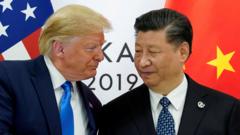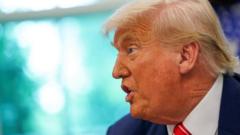**Defense Secretary Pete Hegseth urges NATO members to consider increasing military expenditures to meet strategic threats.**
**NATO Allies Debate Military Spending Amid Trump Administration Pressure**

**NATO Allies Debate Military Spending Amid Trump Administration Pressure**
**Optimism and Division Characterize NATO Meeting on Defense Budgets**
NATO allies showed significant division on Thursday regarding President Trump's demand for member countries to allocate 5 percent of their national income to defense, as the U.S. Defense Secretary expressed optimism about meeting this goal. At a meeting held in Brussels, defense officials from across NATO indicated that concrete decisions on military spending would ultimately rest with the leaders of the 32 member states, who are scheduled to convene in The Hague later this month.
Defense Secretary Pete Hegseth noted that there is "almost near consensus" among allies regarding the necessity of increasing military spending from the current 2 percent of GDP to 5 percent. He highlighted the importance of pooling resources in light of perceived threats, particularly from Russian aggression, which has influenced discussions about funding. Hegseth asserted that while some countries are still hesitant to commit, he remains confident that progress will be made.
Current U.S. defense spending stands at approximately 3.4 percent of GDP, a figure that translates into a significantly larger financial contribution compared to any other NATO member. Although President Trump has proposed a defense budget of $1.01 trillion for the upcoming fiscal year, reaching the 5 percent target would require an additional $200 billion according to estimates provided by the Peterson Institute for International Economics. As tensions remain high, the outcome of the upcoming NATO summit will be crucial in determining the alliance's future military spending strategies.
Defense Secretary Pete Hegseth noted that there is "almost near consensus" among allies regarding the necessity of increasing military spending from the current 2 percent of GDP to 5 percent. He highlighted the importance of pooling resources in light of perceived threats, particularly from Russian aggression, which has influenced discussions about funding. Hegseth asserted that while some countries are still hesitant to commit, he remains confident that progress will be made.
Current U.S. defense spending stands at approximately 3.4 percent of GDP, a figure that translates into a significantly larger financial contribution compared to any other NATO member. Although President Trump has proposed a defense budget of $1.01 trillion for the upcoming fiscal year, reaching the 5 percent target would require an additional $200 billion according to estimates provided by the Peterson Institute for International Economics. As tensions remain high, the outcome of the upcoming NATO summit will be crucial in determining the alliance's future military spending strategies.





















